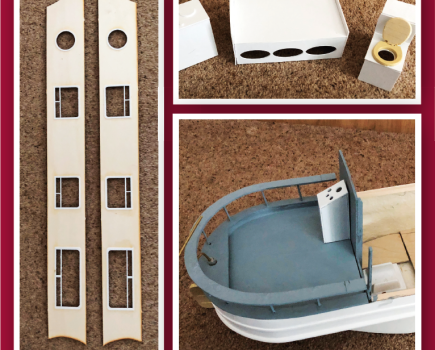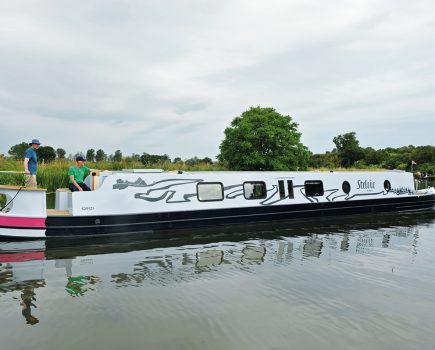Buying a canal boat
BUYING YOUR FIRST BOAT
Have you been boating before? Every now and then, people who have never done anything more than take an afternoon on a canal trip boat, go and order a �70,000 boat to live afloat. Often a few months down the line, they have to sell the boat (at a loss) as their ideas of cruising do not match reality. If you have no experience of boating on inland waterways, then do hire a boat for a week or two, preferably outside of the summer season. Also consider taking a one or two day course in basic boat handling. Have a look around as many boats as you can, go to boat shows, and try and decide what you like and what you don’t.
WHAT DO YOU WANT FROM A BOAT?
For just the odd day or weekend away during the summer, consider a GRP cruiser. Older secondhand boats are quite easy to find from upwards of �1000, although many examples on canals and rivers are quite elderly, but serviceable. New GRP boats are better suited to rivers and cost upwards of �15,000 with 4-stroke petrol outboards. Boats from 16 to 32ft are suitable, sleeping from 2 to 8 people in varying comfort. They do have a tendency to depreciate faster than other craft.For more serious cruising, a narrowboat can comfortably cruise with up to 12 people aboard. They come from 20ft mini boats to 72ft full-length. Modern boats tend to be all-steel, although older ones may have GRP or wood superstructures. Their facilities tend to be better than cruisers, with full-standing headroom, heating, hot water, showers and bigger galleys. Very few narrowboats are less than �10,000 second hand, but they do keep their value much better.If you are only interested in rivers or broad waterways, all-steel cruisers or broad-beam “narrowboat-style” boats are worth considering, but again, deprec-iation from new is quite high. There are not that many used ones around.If you want to live on a boat, do you want to be virtually stationary or cruise about? To move around the entire network, a narrowbeam, with a maximum practical length of 57ft is the answer. If you are happy pottering about locally, then a wider boat offers much more space, without adding too much to the cost.But make sure boat living is for you – what is the longest time you have spent on a boat?
HOW MUCH?
Set a budget early on and look around. Boats can be bought from �100 to over �100,000! Get an idea by scanning the adverts in Canal Boat or in our boats for sale. Check out websites which list more details about craft. Talk to owners when you see them on the towpath, and visit shows like Birmingham, Crick or the IWA national festival.For a narrowboat, around �1000 per foot length of boat is about the bare minimum. There are cheaper starter boats but costs have to be cut somewhere.Be aware of the annual running costs. Around �2000 on a bigger boat is a bare minimum and it’s not much less for smaller craft. Fuel, insurance, licences and moorings are the biggest cost.Allow around ten per cent of the purchase price to equip or maintain the craft initially. Maintenance can be fixed (like painting the hull) and variable, such as equipment failure. You need to have some flexibility in your budget.To finance the purchase, it is possible on boats of over around �25,000 to get a marine mortgage, of 80 per cent or so of the craft’s value, but secured on the boat. For others, a personal loan, overdraft or even a bequest from a relative are all ways that people buy boats. Ensure you have the funds there before committing to buy a craft.
WHERE TO KEEP IT?
A permanent mooring is essential unless you are to be a genuine continuous cruiser. In popular areas moorings are in short supply. Some waiting lists are years long. So, how far are you prepared to travel? In winter that may mean every few weeks to ensure all is well. The further away, the more it discourages regular check-ups.
NEW OR USED?
New boats should come with a warranty and are fitted to the latest safety standards. They are generally bought direct from a builder and cheaper ones come ‘off-the-peg’, with fairly standard layouts.The advantage here is that lead times for delivery are much shorter. There may be some choice in final options and colours, but these may be limited.More costly bespoke boats may take a year or more from initial deposit to actually getting them on the water. Some narrowboat builders can be notorious for missing deadlines. For most this is an irritation, but if you are planning to live aboard, this could be difficult if you are selling a land-based property to finance the boat. (Builders point out that customers can be notorious for changing their minds – decide your layout and try to stick to it to keep the job on time.)Used boats are often good value – depreciation will kick in the moment a new boat hits the water but be aware that the seller is who he/she says they are. They need to provide a bill of sale and/or ownership. For this reason, many boaters buy through a broker, although this is not a guarantee in itself that things are problem free.Using a good surveyor will help ensure that things go as smoothly as possible. Some large brokerages use standardised contracts which can help. Try as many boats as you can, as they are very different, from differing layouts, down to the way they handle.
GETTING BURNED
It is unfortunate, but sometimes a boat-builder suddenly stops trading, leaving potential owners with either very little or nothing to show for their money.Even size is not an indication – several large ones have, in the last few years, gone bust, while smaller companies often keep plodding away, producing fine craft for many years.It is important to have a secure contract, which releases ownership various parts of the boat, such as the shell, to the buyer as the build goes along. Most builders use a contract based on the British Marine Federation (BMF) standard contract. This lays down when monies are to exchange hands and allows possession of some of the completed work, should the builder fail.Usually, a small deposit secures a build slot, then with the commencement of the steelwork stage, the first major payment (but not usually greater than a third of the final price), with further exchanges at the completion of steelwork and perhaps a final staged payment before the last one at handover.Stay in touch with your builder so you are aware that all is well with your boat.
PAPERWORK
All boats under four years old need a certificate of conformity to the Recreational Craft Directive (RCD) usually class D (inland waters) which confirms they have been built to approved standards. This applies to self-builds that are sold by their owner before four years old. At the boat’s fourth birthday, it will need a Boat Safety Certificate (BSC), which needs to be renewed by an examiner every four years. A boat without this paperwork will be unusable, as the navigation authority will need to have copies.
WHEN TO BUY
Boating is now a year-round activity, although there does tend to be a rush on sales at the beginning and end of the season (which is around April to October). Some hire boat companies sell off their boats at the end of a season; these can make good first time buys, as they are usually well maintained.
SHARED OWNERSHIP
As a no-hassle alternative to owning a boat, a number of companies offer shares (often in 1/12th lots). Owners contribute to a fund to pay for maintenance and other costs. Boat useage is divided up into different slots, and companies have various ways of achieving this. In most cases, you can sell the shares on.
WHAT YOU CAN GET FOR YOUR MONEY
Cost (�) Boat
100 Basic canoe or 8ft rowing boat 600 New 3-person inflatable and 3hp outboard motor 1,000 16ft second-hand GRP cruiser with 7.5hp outboard and small 2-berth cabin 3,500 30-year-old 25ft GRP canal cruiser, with 10hp outboard – basic but useable 7,500 15-year-old 20ft all steel outboard powered mini-narrowboat 9,000 27ft river cruiser, with diesel inboard, from early 1970s 15,000 Basic 30ft cruiser style narrowboat, around 20 years old 18,000 New 21ft, 4-berth GRP canal cruiser with new 10hp 4-stroke outboard 24,000 New 28ft outboard powered mini-narrowboat 30,000 Budget 30ft narrowboat with inboard diesel 35,000 Most reasonable quality used narrowboats under 45ft and ex-hire craft 40,000 21ft New trailable aluminium narrowboat with inboard diesel 45,000 New 40ft mid-range narrowboat 50,000 Quality 40ft narrowboat with all mod cons 55,000 Mid league 57ft narrowboat with basic facilities 60,000 57ft narrowboat from major builder, most conveniences 75,000 Basic widebeam ‘narrowboat’ 100,000 Quality bespoke narrowboat, although barges can approach �200,000
NOW READ: HOW TO BUY A BOAT







